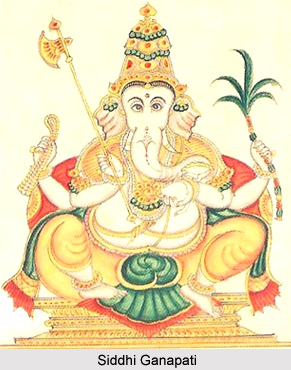 Siddhi Ganapati, also known as Pingala Ganapati, is the Lord of achievement. It is one of the thirty-two forms of Lord Ganesha. The Lord is generally depicted with four arms. But in other depictions, He possesses six arms holding a stick of sugarcane, modakas or sweet balls, a mango, flowers from kalpavriksha, battle-axe and seasamum. Goddess Lakshmi is seated beside Siddhi Ganapati. The elephant headed deity is depicted with a golden yellow complexion. He also holds a sweet ball of jaggery and sesame seeds in his trunk.
Siddhi Ganapati, also known as Pingala Ganapati, is the Lord of achievement. It is one of the thirty-two forms of Lord Ganesha. The Lord is generally depicted with four arms. But in other depictions, He possesses six arms holding a stick of sugarcane, modakas or sweet balls, a mango, flowers from kalpavriksha, battle-axe and seasamum. Goddess Lakshmi is seated beside Siddhi Ganapati. The elephant headed deity is depicted with a golden yellow complexion. He also holds a sweet ball of jaggery and sesame seeds in his trunk.
The Siddhi Ganapati form of Ganesha resembles development and achievement. Siddhi Ganapati is a Tantric form and is worshipped in the rituals of Vamachara Puja Vidhana. Lord Ganesha is worshipped in this form on Ganesh Chaturthi, Ganesh Jayanti, Putra Ganapati Vrata, Durva Ganapati Vrata and other festivals. The devotees of Siddhi Ganesha attain siddhi and prosperity. Some of the renowned temples of Siddhi Ganapati or Pingala Ganapati are Shree Siddhi Vinayaka Temple in Mumbai, Maharashtra state, Nanjangud and Chamarajanagar in the district of Mysore, Karnataka etc.
Lord Ganesha is worshipped with a devotional hymn known as Siddhi Ganapati Mantram or Siddhi Ganesha Dhyanam. It can be recited as follows-
Pakva Chootha Phala Kalpa Manjaree
Mikshu Rasaathala Modakaissaha
Udwahan Parashu Hasthathe Namah
Sri Sahaayayutha Deva Pingala.
This article is a stub. You may enrich it by adding more information to it. You can send your write-up at content@indianetzone.com









